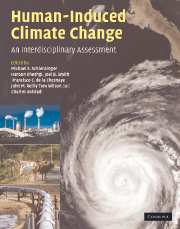Book contents
- Frontmatter
- Contents
- List of contributors
- Preface
- Part I Climate system science
- 1 The concept of climate sensitivity: history and development
- 2 Effect of black carbon on mid-troposphere and surface temperature trends
- 3 Evaluating the impacts of carbonaceous aerosols on clouds and climate
- 4 Probabilistic estimates of climate change: methods, assumptions and examples
- 5 The potential response of historical terrestrial carbon storage to changes in land use, atmospheric CO2, and climate
- 6 The albedo climate impacts of biomass and carbon plantations compared with the CO2 impact
- 7 Overshoot pathways to CO2 stabilization in a multi-gas context
- 8 Effects of air pollution control on climate: results from an integrated global system model
- Part II Impacts and adaptation
- Part III Mitigation of greenhouse gases
- Part IV Policy design and decisionmaking under uncertainty
- Index
- Plate section
- References
3 - Evaluating the impacts of carbonaceous aerosols on clouds and climate
from Part I - Climate system science
Published online by Cambridge University Press: 06 December 2010
- Frontmatter
- Contents
- List of contributors
- Preface
- Part I Climate system science
- 1 The concept of climate sensitivity: history and development
- 2 Effect of black carbon on mid-troposphere and surface temperature trends
- 3 Evaluating the impacts of carbonaceous aerosols on clouds and climate
- 4 Probabilistic estimates of climate change: methods, assumptions and examples
- 5 The potential response of historical terrestrial carbon storage to changes in land use, atmospheric CO2, and climate
- 6 The albedo climate impacts of biomass and carbon plantations compared with the CO2 impact
- 7 Overshoot pathways to CO2 stabilization in a multi-gas context
- 8 Effects of air pollution control on climate: results from an integrated global system model
- Part II Impacts and adaptation
- Part III Mitigation of greenhouse gases
- Part IV Policy design and decisionmaking under uncertainty
- Index
- Plate section
- References
Summary
Introduction
Any attempt to reconcile observed surface temperature changes within the past 150 years to changes simulated by climate models that include various atmospheric forcings is sensitive to the changes attributed to aerosols and aerosol–cloud–climate interactions, which are the main contributors that may well balance the positive forcings associated with greenhouse gases, absorbing aerosols, ozone related changes, etc. These aerosol effects on climate, from various modeling studies discussed in Menon (2004), range from + 0.8 to − 2.4 W/m2, with an implied value of − 1.0 W/m2 (range from − 0.5 to − 4.5 W/m2) for the aerosol indirect effects. Quantifying the contribution of aerosols and aerosol–cloud interactions remains complicated for several reasons, some of which are related to aerosol distributions and some to the processes used to represent their effects on clouds. Aerosol effects on low-lying marine stratocumulus clouds that cover much of the Earth's surface (about 70%) have been the focus of most prior simulations of aerosol–cloud interaction effects. Since cumulus clouds (shallow and deep convective) are short-lived and cover about 15 to 20% of the Earth's surface, they are not usually considered as radiatively important. However, the large amount of latent heat released from convective towers, and corresponding changes in precipitation, especially in biomass regions owing to convective heating effects (Graf et al., 2004), suggest that these cloud systems, and aerosol effects on them, must be examined more closely.
- Type
- Chapter
- Information
- Human-Induced Climate ChangeAn Interdisciplinary Assessment, pp. 34 - 48Publisher: Cambridge University PressPrint publication year: 2007
References
- 16
- Cited by



